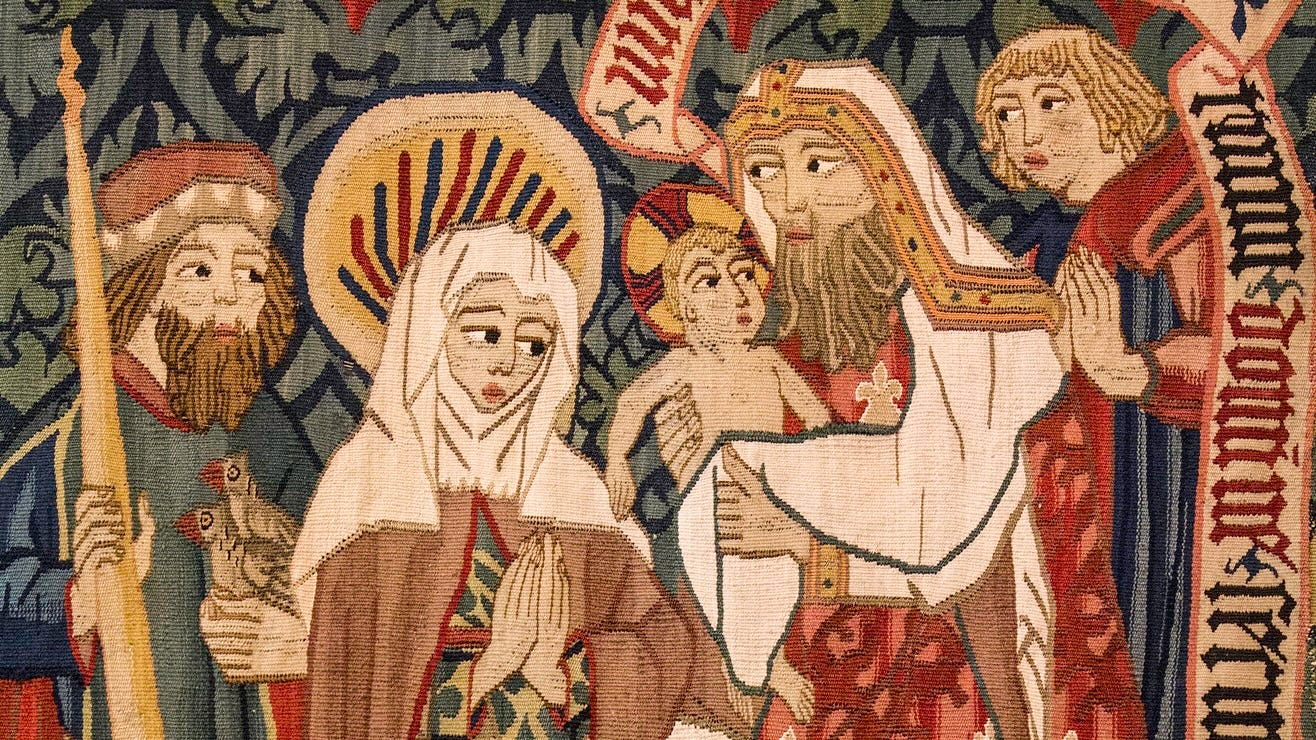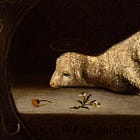Why was Jesus so joyful at the Presentation in the Temple?
Our Lord's prophesied Presentation was the 'Offertory of the Passion' and the ritual beginning of what he was born to do.

Christ's Presentation was the 'Offertory of the Passion' and the ritual beginning of what he was born to do.
Editor’s Notes
First, we should note that Catholic tradition understands Christ to have enjoyed perfect use of his reason and will from the first moment of his conception.
Because of this, we can justly consider what he thought, willed and felt at different points of his life in Our Lady’s womb, and his infancy.
In this piece, Father Coleridge tells us…
Why Our Lord’s Presentation in the Temple was a moment of deep joy for him, as he offered himself to the Eternal Father for the mission he had come to fulfil
How Our Lady and St. Joseph shared in this joy, giving thanks for the fulfilment of God’s promises and embracing the privilege of offering Christ in the Temple
What this event teaches us about true devotion—how souls who love God seek out his presence, not from obligation, but from an eager desire to serve and worship him.
There are three key features to the Presentation.
1. The Temple
Coleridge shows us that, though outwardly humble and unnoticed, this Presentation was the moment that raised the Temple’s glory to its highest point.
“The Desired of all Nations” had come, bringing with him a searching purity before which all sin is consumed. His coming fulfilled the messianic prophecy, that the Messias—God himself—would come in person specifically to the Second Temple.
The destruction of this Temple should itself be proof to the Jewish people that their promised Messias has already come; if he has not come already, then this prophecy cannot be fulfilled, even if they build a third Temple.
2. Manifestation to the Chosen People
In addition, the Presentation marked a formal manifestation to the Jewish people in the person of Simeon, with Simeon being to the Jews what the Wise Men were to the rest of humanity.
We often thing of the Wise Men being the contemporaries of the Shepherds; but in fact, there are reasons to think that they came after the Presentation, and being more fittingly linked with Simeon in the Temple.
3. The Offertory of the Passion
As discussed elsewhere, the law of presenting and redeeming the first-born was instituted in remembrance of Israel’s deliverance from Egypt when the first-born of the Egyptians were slain. God claimed the first-born of Israel as his own, but rather than demanding their blood, he allowed them to be redeemed by the sacrifice of an animal, signifying their consecration to him.
This ritual foreshadowed Christ, who, though not bound by the law, submitted to it in his presentation at the temple. Unlike others, his life would not ultimately be redeemed by an animal sacrifice—he was the true Passover lamb, whose blood would be shed to cleanse from sin and bring salvation. His presentation was the fulfilment of all that the law prefigured, as our Lord was solemnly offered to the Father, not in mere symbol, but in the reality of his sacrificial mission.
The joy of this moment—which we could almost call “the Offertory of the Passion”—is the focus for Father Coleridge in this piece, as he explores in depth its meaning for Our Lord, Our Lady, and St Joseph.
See also:
The Purification
The Thirty Years—Our Lord’s Infancy & Hidden Life
Ch. V, pp 109-121
St. Luke ii. 22-39; Story of the Gospels, § 11
Burns and Oates, London, 1885 (1915 edition).
Headings and some line breaks added.
Sung on the feast of Candlemas
Great joy
It must also have been a great joy to our Lord to present Himself for the first time, in the Temple, to His Eternal Father, to acknowledge His absolute dependence on Him, and to offer Himself there for the great work for which He came into the world.
And if this was so with Him, so also would it be a joy and solemn delight to our Blessed Lady to do her part in this solemn Presentation. “I rejoiced,” says one of the Gradual Psalms, “at the things that were said to me, We shall go into the house of the Lord!” and the thoughts which follow in that beautiful canticle must have been in her heart while they were on their way to Jerusalem.1
It was the first time they had gone to the Holy City since the ineffable blessing of the Birth of our Lord. He had to offer Himself to His Father, she had to give thanks for the accomplishment of the promises made to her, and St. Joseph also had to pour out his grateful heart to God Who had chosen him for so high an office, and enabled him hitherto to discharge it with faithfulness and success.
And in all this we see, not only what any bystander might have seen, the careful fulfilment of and obedience to all the prescriptions of the Law, but also that “fulfilling” of the Law in another and a higher sense, of which our Lord seems to have spoken to St. John, at the time of His own Baptism.
For it was by our Lord’s Baptism that water was consecrated for the sacrament of regeneration. It was by our Lord’s Circumcision that efficacy was connected with that rite for the cancelling of original sin.
So it was by the fulfilment on the part of our Lord, and His Blessed Mother, of these prescriptions of the Law, that they had allied to them the blessings which had been imparted, in a long series of generations, to those who had faithfully observed them.
Joy in Christian privileges
Thus in itself to our Lord and to the two holy souls by His side, Mary and Joseph, the occasion of the Purification was one of intense joy.
But why was it one of joy? Subscribe now to find out.
Nearly all the material we publish here is free for all—but curating it takes a lot of time and resources. A monthly/annual subscription really makes a difference—and makes it possible to carry on:




